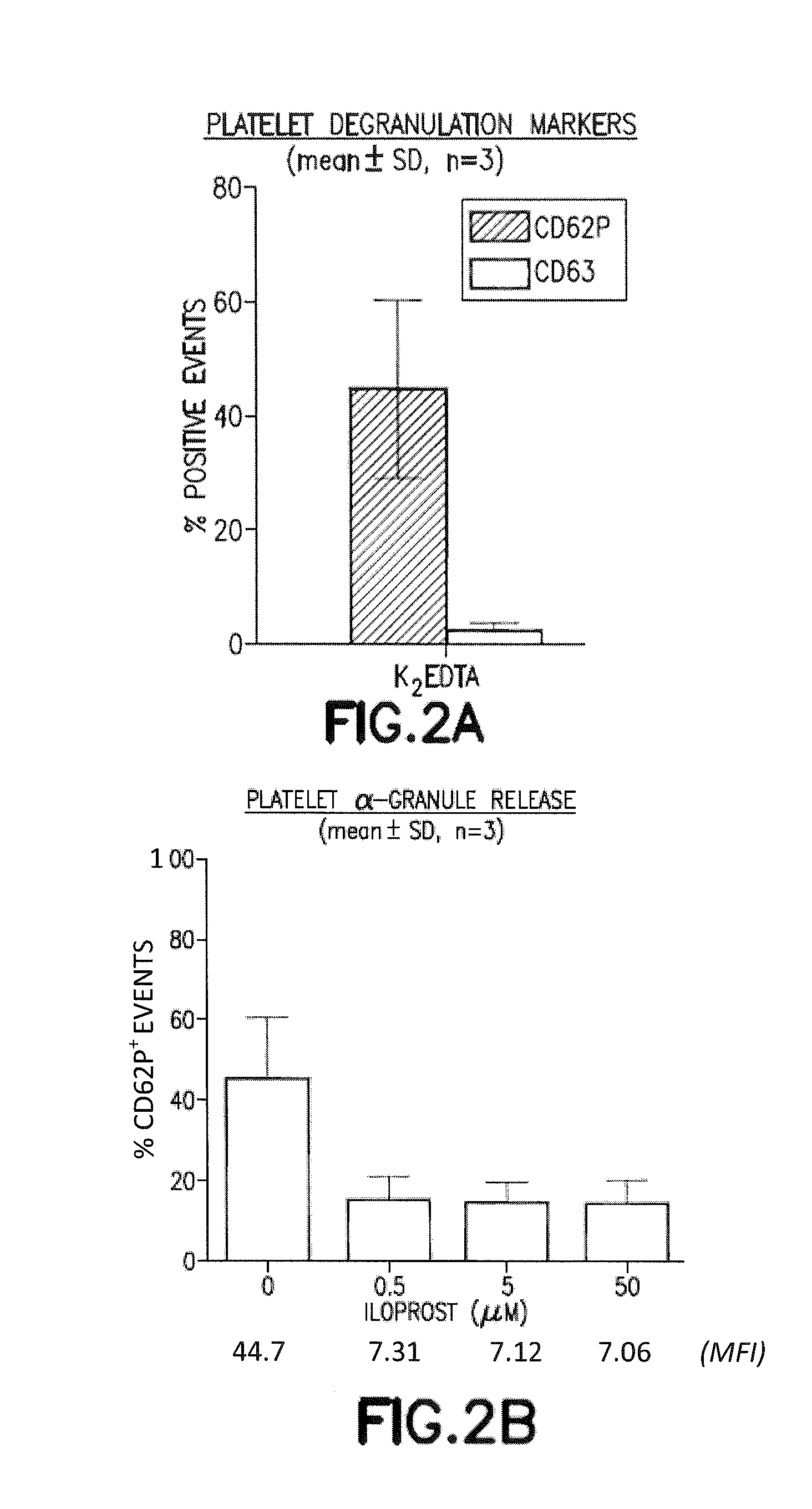Sample collection devices with blood stabilizing agents
a technology of blood stabilizing agent and sample collection device, which is applied in the direction of instruments, catheters, laboratory glassware, etc., can solve the problems of unsuitable platelet activation measurement, edta use is greatly hampered, and molecules cannot be efficiently stabilized
- Summary
- Abstract
- Description
- Claims
- Application Information
AI Technical Summary
Benefits of technology
Problems solved by technology
Method used
Image
Examples
example 1
Iloprost Inhibits EDTA-Mediated Spontaneous Platelet Degranulation
[0075]Platelet activation can result in a robust and rapid release of α-granules, dense granules, and lysosomes, the contents of which serve to promote a variety of autocrine and paracrine signal transduction events. CD62P (P-selectin) is an adhesion molecule that is transiently expressed on the platelet plasma membrane following α-granule release and can mediate platelet-leukocyte aggregates via ligation with leukocyte expressed P-selectin glycoprotein ligand 1 (PSGL-1 / CD162). Dense granule and lysosome release can be measured, although not distinguished, with CD63 surface expression. Previous studies demonstrate that ETDA induces surface expression of CD62P and CD63.
[0076]The effect of EDTA on platelet activation, as judged by CD62P and CD63 surface expression, was evaluated in the presence or absence of the platelet stabilization agent (iloprost). Whole blood was collected into tubes containing EDTA or EDTA with il...
example 2
Iloprost Inhibits Agonist-Induced Platelet Degranulation in EDTA for α-Granules and for Dense / Lysosomal Release
[0078]The effect of iloprost on platelet activation was studied in the presence of strong platelet-activating agents, ADP and thrombin-receptor activating peptide (TRAP). Platelet stimulations were performed by adding 300 μL blood to micro-centrifuge tubes containing 10 μL of saline (0.85%), ADP, or TRAP-6 and incubating for approximately 2 min at RT. Final concentrations of ADP and TRAP-6 were 6.5 μM and 32 μM, respectively. Afterwards, whole blood flow cytometry was performed as described above. Blood collection and flow cytometry was performed as described in example 1.
[0079]Addition of ADP increased the CD62P expression from 44.6% in EDTA alone (resting sample) to 85.1% while TRAP activation reached 99.4% (FIG. 3A). Addition of iloprost resulted in reduced expression of CD62P to 15.0% in resting samples and 17.3% or 33.4% in ADP or TRAP activated samples with the additi...
example 3
Iloprost Inhibits EDTA-Mediated Degranulation Out to 24 Hr of Sample Dwell
[0080]As shown in FIG. 4A, expression of CD62P was analyzed as described in example 1 at t=0, 2, 8 and 24 hr of sample dwell. FIG. 4B shows the percentage of CD62+ events for each condition at each timepoint shown as the mean±SD for 10 subjects. The table below shows the median fluorescent intensity for all platelet events at each timepoint for 10 subjects.
MFI Over Time0 hrs2 hrs8 hrs24 hrsEDTA20.2142.6633.1463.02EDTA + Iloprost4.084.495.1311.25
PUM
 Login to View More
Login to View More Abstract
Description
Claims
Application Information
 Login to View More
Login to View More - R&D
- Intellectual Property
- Life Sciences
- Materials
- Tech Scout
- Unparalleled Data Quality
- Higher Quality Content
- 60% Fewer Hallucinations
Browse by: Latest US Patents, China's latest patents, Technical Efficacy Thesaurus, Application Domain, Technology Topic, Popular Technical Reports.
© 2025 PatSnap. All rights reserved.Legal|Privacy policy|Modern Slavery Act Transparency Statement|Sitemap|About US| Contact US: help@patsnap.com



